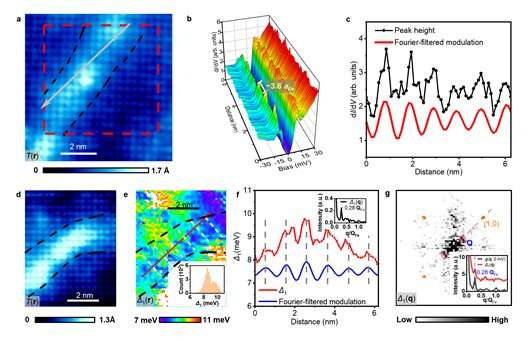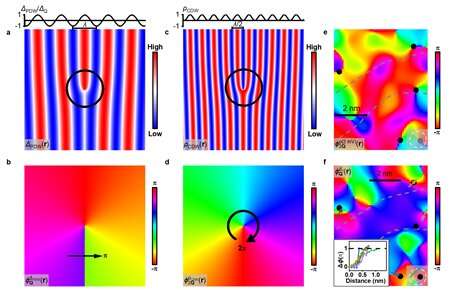As a macroscopic quantum state of matter, superconductivity has attracted tremendous attention in the field of scientific research and industry over the past century. According to the BCS (Bardeen-Cooper-Schrieffer) microscopic theory, superconductivity arises from the condensation of coherent Cooper pairs, and each Cooper pair is formed by two electrons with opposite spins and momenta.
Theoretically, when time-reversal symmetry is broken, Cooper pairs may acquire a finite momentum and exhibit a spatially modulated superconducting order parameter, which is known as the Fulde-Ferrell-Larkin-Ovchinnikov (FFLO) state. Although the FFLO state was theoretically proposed in 1964, it has proven challenging to observe the FFLO state due to the stringent requirement for materials. To date, direct evidences of the FFLO state, such as the modulation of the superconducting order parameter in real space, have not been detected experimentally.
To understand the observed two-dimensional (2D) superconducting properties in cuprates, some theoretical works predicted that the finite-momentum Cooper pairs can exist in strong-coupling systems without breaking time-reversal symmetry and show the spatial modulation of Cooper-pair density. This extraordinary superconducting state, referred to as the pair density wave (PDW), has sparked numerous theoretical investigations due to the potential connection between the PDW and unconventional superconductivity.
Among various theoretical hypotheses, the most intriguing one is that the PDW is another principal state along with d-wave superconductivity in the phase diagram of cuprates, which provides new insights into the complex intertwined orders of the cuprates showing high-temperature superconductivity. Moreover, according to some theoretical proposals, the enigmatic pseudogap phase of cuprates can be attributed to the PDW state, further indicating the potential importance of PDW.
However, experimental evidences of the PDW state in high-temperature (high-Tc) superconductors have only been observed in some cuprates. The existence of PDW state in iron-based superconductors, another high-Tc superconductor family, has never been experimentally detected. Furthermore, early theoretical studies of cuprates proposed the PDW is a low-dimensional stripe order in 2D systems, but no compelling experimental evidences of the PDW in 2D systems have been reported so far.
Recently, Prof. Jian Wang’s group at Peking University, in collaboration with Prof. Ziqiang Wang at Boston College and Prof. Yi Zhang at Shanghai University, discovered the primary pair density wave state in a 2D iron-based high-Tc superconductor, which provides a new 2D high-Tc platform to investigate the PDW in unconventional superconductors. Their paper is published in the journal Nature.
By using molecular beam epitaxy (MBE) technique, Jian Wang’s group successfully grew large-area and high-quality one-unit-cell-thick Fe(Te,Se) films on SrTiO3(001) substrates (1-UC Fe(Te,Se)/STO), which show superconducting gap as large as 18 meV, much higher than that (~1.8 meV) in bulk Fe(Te,Se), a promising topological superconductor candidate.
Previously, the Jian Wang group and collaborators discovered zero-energy excitations at both ends of 1D atomic line defects in 1-UC Fe(Te,Se)/STO, which are found to be consistent with the Majorana zero modes interpretation (Nat. Phys. 16, 536-540 (2020)). In the current work, another atomic structure in 1-UC Fe(Te,Se)/STO, the innate domain wall where the atomic lattice is compressed along Fe-Fe direction across the domain wall (Fig. 1a–d), was investigated by in situ low-temperature (4.3 K) scanning tunneling microscopy/spectroscopy (STM/STS). Within the domain wall area, clear spatial modulation of the local density of stats (LDOS) is detected (Fig. 1e–f).
By performing the 2D lock-in analysis (Fig. 1g–h), a modulation period of 3.6aFe (aFe is the distance between neighboring Fe atoms) is determined. Further bias voltage dependent measurements show that the period of the LDOS modulation is independent of the energy, demonstrating an origin of electronic order. Furthermore, the electronic ordering-induced LDOS modulations mainly exist in the energies within the superconducting gap, indicating that the charge order is potentially related to the superconductivity of 1-UC Fe(Te,Se)/STO.

By performing further STS measurements, spatial modulations of the superconducting coherence peak height (Fig. 2a–c) and gap energy (Fig. 2d–f) are detected at the domain wall. Previous studies have reported the strong correlation between these two physical quantities and the superconducting order parameter. Therefore, the spatial modulation of the superconducting order parameter is directly observed in real space, which provides compelling evidence of the existence of PDW order in the 2D iron-based high-temperature superconductor.

Apart from the PDW state, a charge density wave (CDW) state with a period of about 1.8aFe (half of the period of PDW) is also detected at the domain wall. Fig. 3e and 3f show the phase map of the PDW (period ~ 3.6aFe) and CDW state (period ~ 1.8aFe) at the domain wall, in which vortices with 2π phase winding in the CDW phase (black dots in Fig. 3e) and π-phase shifts in the PDW phase (arrows in Fig. 3f) can be identified. It is clear that the π-phase shifts in the PDW phase are observed near the vortices of the CDW, which is consistent with the theoretical scenario of a primary PDW and PDW-induced secondary CDW (Fig. 3a-d). Therefore, the PDW state observed at the domain wall of 1-UC Fe(Te,Se)/STO is a primary state.
To explain the mechanism of the primary PDW state at the domain wall, Prof. Ziqiang Wang and Prof. Yi Zhang proposed a novel triplet equal-spin pairing model. At the domain wall, the broken inversion and mirror symmetry introduce the Rashba and Dresselhaus spin-orbit couplings (SOC). Due to the large SOC, electrons with equal spin can pair across the Fermi points of the SOC splitting bands, leading to a primary PDW state with finite-momentum Cooper pairs. Theoretical calculations based on the equal-spin pairing model show the spatial modulation of the LDOS and the superconducting gap, which are consistent with our experimental results and reveal the possible existence of topological spin-triplet superconducting order parameters.
More information:
Jian Wang, Pair density wave state in a monolayer high-Tc iron-based superconductor, Nature (2023). DOI: 10.1038/s41586-023-06072-x. www.nature.com/articles/s41586-023-06072-x
Citation:
Discovery of pair density wave state in a two-dimensional high-Tc iron-based superconductor (2023, June 28)
retrieved 3 July 2023
from
This document is subject to copyright. Apart from any fair dealing for the purpose of private study or research, no
part may be reproduced without the written permission. The content is provided for information purposes only.

